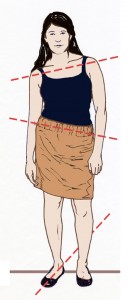 Psoas major pain can be fairly amorphous and problems with the psoas can manifest as lower back pain, hip pain, groin pain, as well as knee, shoulder, neck and foot pain.
Psoas major pain can be fairly amorphous and problems with the psoas can manifest as lower back pain, hip pain, groin pain, as well as knee, shoulder, neck and foot pain.
Is that enough for you? But foot pain you ask? Really, foot pain?
Well, one of my many phrases is your big toe is your psoas.
The psoas major attaches on the back half of the inner thigh and along the entire lumbar (lower) spine as well as the bottom of the middle (thoracic T12) spine.
The psoas need to be aligned on the back half of the inner thigh to work its true magic as a muscle that holds the spine successfully on top of the pelvis.
If you are standing on your feet or walking, and grounding effectively through the inside (which doesn’t mean collapsing your arch) you will be activating the inner upper thigh, particularly a muscle called adductor magnus which attaches to your sit bone (ischial tuberosity) as well as the pubic bone.
When this inner thigh muscle activates it helps to rotate the leg internally which sets the psoas into the back plane of the body so that it can do its thing, and a powerful thing it is.
One of the issues that tend to lead to psoas major pain is when the psoas is pulled into the front plane of the body.
When the psoas major is constricted it externally rotates the inner thigh and foot, pulling the thigh forward and open, while hiking up the hip and pulling the shoulder down.
This is usually the beginning phase of psoas tightness that can get much worse pulling the ribs and spine in all different directions.
Psoas major pain as it relates to the foot or the big toe shows itself because the tightness of the psoas major pulls the foot out of its ability to ground evenly through the whole foot.
This often shows itself in the affected foot seeming to have a high arch. When a foot is aligned this way it is difficult to ground through the whole foot compounding everything.
This doesn’t always show in foot pain—this same alignment can affect and hurt the knee similarly.
It is a big conundrum though because the tight psoas major doesn’t allow the foot to ground to set the psoas back at its base and the foot that can’t ground through its entirety can’t help to activate adductor magnus which supports the psoas.
So what is a body to do to alleviate psoas major pain?
Release the psoas out of its tight environment—which doesn’t always mean stretching—and change your movement patterns to access the inner foot with each step. Those are two great places to start.
